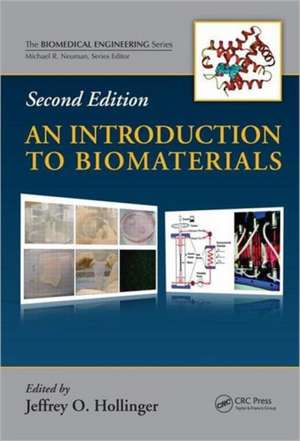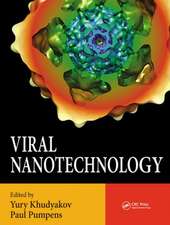An Introduction to Biomaterials: Biomedical Engineering
Editat de Jeffrey O. Hollingeren Limba Engleză Hardback – 28 noi 2011
Divided into four sections (Biology, Biomechanics, Biomaterials Interactions; Biomaterials Testing, Statistics, Regulatory Considerations, Intellectual Property; Biomaterials Compositions; and Biomaterials Applications), this dramatically revised edition includes both new and revised chapters on cells, tissues, and signaling molecules in wound healing cascades, as well as two revised chapters on standardized materials testing with in vitro and in vivo paradigms consistent with regulatory guidelines. Emphasizing biocompatibility at the biomaterial-host interface, it investigates cell-cell interactions, cell-signaling and the inflammatory and complement cascades, specific interactions of protein-adsorbed materials, and other inherent biological constraints including solid-liquid interfaces, diffusion, and protein types. Unique in its inclusion of the practicalities of biomaterials as an industry, the book also covers the basic principles of statistics, new U.S. FDA information on the biomaterials-biology issues relevant to patent applications, and considerations of intellectual property and patent disclosure.
With nine completely new chapters and 24 chapters extensively updated and revised with new accomplishments and contemporary data, this comprehensive introduction discusses 13 important classes of biomaterials, their fundamental and applied research, practical applications, performance properties, synthesis and testing, potential future applications, and commonly matched clinical applications. The authors include extensive references, to create a comprehensive, yet manageable didactic work that is an invaluable desk references and instructional text for undergraduates and working professionals alike.
Din seria Biomedical Engineering
- 22%
 Preț: 450.88 lei
Preț: 450.88 lei - 23%
 Preț: 619.56 lei
Preț: 619.56 lei - 35%
 Preț: 557.07 lei
Preț: 557.07 lei - 23%
 Preț: 794.10 lei
Preț: 794.10 lei - 5%
 Preț: 808.68 lei
Preț: 808.68 lei - 11%
 Preț: 629.79 lei
Preț: 629.79 lei - 23%
 Preț: 549.27 lei
Preț: 549.27 lei - 22%
 Preț: 605.36 lei
Preț: 605.36 lei - 29%
 Preț: 868.53 lei
Preț: 868.53 lei - 8%
 Preț: 423.60 lei
Preț: 423.60 lei - 25%
 Preț: 690.65 lei
Preț: 690.65 lei - 21%
 Preț: 339.72 lei
Preț: 339.72 lei - 5%
 Preț: 1160.05 lei
Preț: 1160.05 lei -
 Preț: 379.25 lei
Preț: 379.25 lei -
 Preț: 447.05 lei
Preț: 447.05 lei - 18%
 Preț: 560.53 lei
Preț: 560.53 lei - 18%
 Preț: 953.44 lei
Preț: 953.44 lei - 18%
 Preț: 967.93 lei
Preț: 967.93 lei - 18%
 Preț: 1292.62 lei
Preț: 1292.62 lei - 15%
 Preț: 585.30 lei
Preț: 585.30 lei - 26%
 Preț: 1161.10 lei
Preț: 1161.10 lei -

Preț: 782.99 lei
Preț vechi: 1113.80 lei
-30% Nou
Puncte Express: 1174
Preț estimativ în valută:
149.83€ • 160.22$ • 124.92£
149.83€ • 160.22$ • 124.92£
Carte tipărită la comandă
Livrare economică 18 aprilie-02 mai
Preluare comenzi: 021 569.72.76
Specificații
ISBN-13: 9781439812563
ISBN-10: 143981256X
Pagini: 644
Ilustrații: 223 b/w images, 64 tables and 96
Dimensiuni: 178 x 254 x 30 mm
Greutate: 1.5 kg
Ediția:Revizuită
Editura: CRC Press
Colecția CRC Press
Seria Biomedical Engineering
ISBN-10: 143981256X
Pagini: 644
Ilustrații: 223 b/w images, 64 tables and 96
Dimensiuni: 178 x 254 x 30 mm
Greutate: 1.5 kg
Ediția:Revizuită
Editura: CRC Press
Colecția CRC Press
Seria Biomedical Engineering
Public țintă
Students and researchers in biomedical engineering, biomaterials, and biochemistry.Cuprins
Consensus Definitions, Fundamental Concepts, and a Standardized Approach to Applied Biomaterials Sciences. Biology, Biomechanics, Biomaterial Interactions: Wound Healing Biology. Cutaneous Wound Pathobiology: Raison d’etre for Tissue Engineering. Osseous Wound Healing. Biology, Biomechanics, Biomaterial Interactions: Cellular Mechanics. Cell and Tissue Mechanobiology. Biology, Biomechanics, Biomaterial Interactions: Materials–Host Interactions. Cell–Material Interactions: Fundamental Design Issues for Tissue Engineering and Clinical Considerations. Host Response to Biomaterials. Protein Adsorption at the Biomaterial–Tissue Interface. Biomaterials Testing, Statistics, Regulatory Considerations, Intellectual Property: Standardized Materials Testing. In Vitro Testing of Biomaterials. Assessment of Biomaterials: Standardized In Vivo Testing. Biomaterials Testing, Statistics, Regulatory Considerations, Intellectual Property: Statistics. Basic Principles of Statistics: Considerations for Biomaterials Engineers. Therapy Development, Animal Testing, and Regulatory Issues. Fundamentals of Patenting for the Biomaterials Scientist. Biomaterials Compositions. Proteins and Amino Acid–Derived Polymers. Three-Dimensional Fibrin Constructs in Tissue Engineering. Biomedical Polyurethanes. Polymers Derived from l-Tyrosine. Poly(propylene Fumarate). Complex Polysaccharides: Chitosan and Alginate. Collagen: A Natural Biomaterial for Tissue Engineering. Polyphosphazenes. Biologically Active Glasses. Silk-Based Biomaterials: Biology, Properties, and Clinical Applications. Calcium-Based Bioceramics: Biology, Properties, and Clinical Applications. Biomaterials Applications. Tissue Engineering of Skin. Polymeric Biomaterials for Drug and Nucleic Acid Delivery. Orthopedic Prostheses and Joint Implants. Bone and Biomaterials. Functional Regeneration of Synovial Joints In Vivo: The Role of Biomaterials and Scaffold Design. Tissue Engineering, Biomaterials, and the Nervous System. Ligaments, Biomaterials, and Tissue-Engineering Opportunities. Cardiovascular Tissue Engineering and Biomaterials. Index.
Notă biografică
Dr. Jeffrey O. Hollinger graduated from Hofstra University in 1969 and received a dental degree and PhD from the University of Maryland in 1973 and 1981, respectively. In addition, he completed a dental residency program and craniofacial fellowship in the U.S. Army Dental Corps. Since 2000, Dr. Hollinger has been a tenured professor at Carnegie Mellon University (CMU) in the departments of biomedical engineering and biological sciences. He is the director of the Bone Tissue Engineering Center at CMU.
From 1993 to 2000, he was a tenured professor at the Oregon Health Sciences University in the departments of surgery and developmental biology, and he directed the Northwest Wound Healing Center. In 1993 Dr. Hollinger retired from the U.S. Army as a colonel after serving 20 years of active duty. During that period, he was the director of the Army’s Bone Program, as well as the director of the Department of Physiology and Biochemistry at the U.S. Army Institute of Dental Research at the Walter Reed Army Medical Center in Washington, DC. He has over 35 years of experience in bone regeneration using biological factors, biomaterials, and preclinical animal models.
Dr. Hollinger has received numerous federal grants as the principal investigator (NIH, NSF, DoD, and NIST) focusing on applied and fundamental sciences for bone regeneration and is engaged with several industrial groups emphasizing bone regenerative therapeutics, as well as serving on corporate boards. Dr. Hollinger has several patents and has licensed technology developed in his lab. He received the prestigious Clemson Award in biomaterials in 2008. He has over 250 peer-reviewed publications, abstracts, book chapters, and books.
From 1993 to 2000, he was a tenured professor at the Oregon Health Sciences University in the departments of surgery and developmental biology, and he directed the Northwest Wound Healing Center. In 1993 Dr. Hollinger retired from the U.S. Army as a colonel after serving 20 years of active duty. During that period, he was the director of the Army’s Bone Program, as well as the director of the Department of Physiology and Biochemistry at the U.S. Army Institute of Dental Research at the Walter Reed Army Medical Center in Washington, DC. He has over 35 years of experience in bone regeneration using biological factors, biomaterials, and preclinical animal models.
Dr. Hollinger has received numerous federal grants as the principal investigator (NIH, NSF, DoD, and NIST) focusing on applied and fundamental sciences for bone regeneration and is engaged with several industrial groups emphasizing bone regenerative therapeutics, as well as serving on corporate boards. Dr. Hollinger has several patents and has licensed technology developed in his lab. He received the prestigious Clemson Award in biomaterials in 2008. He has over 250 peer-reviewed publications, abstracts, book chapters, and books.
Descriere
The second edition of this popular text includes nine new chapters that provide a comprehensive and up-to-date educational framework for biomaterials education. A new chapter on the biology of wound healing sets the stage for the basic requirements of standardized biomaterials testing and explains the reactions between biomaterials and the living system into which it is implanted. The book explains in vitro and in vivo testing paradigms and provides numerous examples in the chapters on experimental design, laboratory assays, and animal models. Emphasizing the importance of the regulatory process, it describes how innovation in the biomaterials process relates to patentability and inventorship.
















